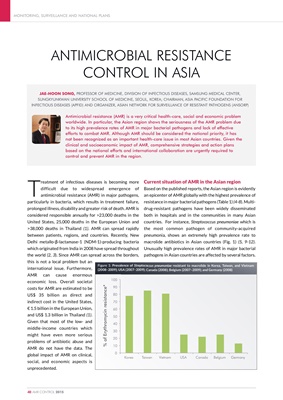
MONITORING, SURVEILLANCE AND NATIONAL PLANS
40 AMR CONTROL 2015
T
reatment of infectious diseases is becoming more
difficult due to widespread emergence of
antimicrobial resistance (AMR) in major pathogens,
particularly in bacteria, which results in treatment failure,
prolonged illness, disability and greater risk of death. AMR is
considered responsible annually for >23,000 deaths in the
United States, 25,000 deaths in the European Union and
>38,000 deaths in Thailand (1). AMR can spread rapidly
between patients, regions, and countries. Recently, New
Delhi metallo-β-lactamase-1 (NDM-1)-producing bacteria
which originated from India in 2008 have spread throughout
the world (2, 3). Since AMR can spread across the borders,
this is not a local problem but an
international issue. Furthermore,
AMR can cause enormous
economic loss. Overall societal
costs for AMR are estimated to be
US$ 35 billion as direct and
indirect cost in the United States,
€ 1.5 billion in the European Union,
and US$ 1.3 billion in Thailand (1).
Given that most of the low- and
middle-income countries which
might have even more serious
problems of antibiotic abuse and
AMR do not have the data. The
global impact of AMR on clinical,
social, and economic aspects is
unprecedented.
Current situation of AMR in the Asian region
Based on the published reports, the Asian region is evidently
an epicenter of AMR globally with the highest prevalence of
resistance in major bacterial pathogens (Table 1) (4-8). Multidrug-resistant
pathogens have been widely disseminated
both in hospitals and in the communities in many Asian
countries. For instance, Streptococcus pneumoniae which is
the most common pathogen of community-acquired
pneumonia, shows an extremely high prevalence rate to
macrolide antibiotics in Asian countries (Fig. 1) (5, 9-12).
Unusually high prevalence rates of AMR in major bacterial
pathogens in Asian countries are affected by several factors.
ANTIMICROBIAL RESISTANCE
CONTROL IN ASIA
JAE-HOON SONG, PROFESSOR OF MEDICINE, DIVISION OF INFECTIOUS DISEASES, SAMSUNG MEDICAL CENTER,
SUNGKYUNKWAN UNIVERSITY SCHOOL OF MEDICINE, SEOUL, KOREA; CHAIRMAN, ASIA PACIFIC FOUNDATION FOR
INFECTIOUS DISEASES (APFID) AND ORGANIZER, ASIAN NETWORK FOR SURVEILLANCE OF RESISTANT PATHOGENS (ANSORP)
Antimicrobial resistance (AMR) is a very critical health-care, social and economic problem
worldwide. In particular, the Asian region shows the seriousness of the AMR problem due
to its high prevalence rates of AMR in major bacterial pathogens and lack of effective
efforts to combat AMR. Although AMR should be considered the national priority, it has
not been recognized as an important health-care issue in most Asian countries. Given the
clinical and socioeconomic impact of AMR, comprehensive strategies and action plans
based on the national efforts and international collaboration are urgently required to
control and prevent AMR in the region.
0
10
20
30
40
50
60
70
80
90
100
Korea Taiwan Vietnam USA Canada Belgium Germany
% of Erythromycin resistance*
Figure 1: Prevalence of Streptococcus pneumoniae resistant to macrolide in Korea, Taiwan, and Vietnam
(2008-2009); USA (2007-2009); Canada (2008); Belgium (2007-2009); and Germany (2008)